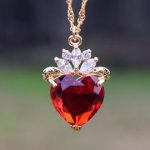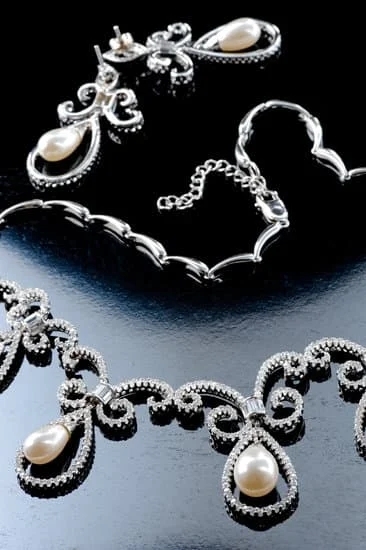The history of jewelry design spans centuries and cultures, showcasing the creativity and craftsmanship of human civilization. From ancient civilizations to modern-day innovations, jewelry has played a significant role in personal adornment, cultural symbolism, and artistic expression. This article will explore the evolution of jewelry design, from its early origins to its enduring legacy in contemporary fashion and culture.
Ancient civilizations such as Egypt and Mesopotamia set the stage for the art of jewelry-making, using precious materials like gold, silver, and gemstones to create intricate designs that reflected their religious beliefs, social status, and cultural traditions. The Renaissance period also saw a resurgence of interest in jewelry design, with exquisite pieces showcasing fine enamel work, intricate filigree, and precious stones.
The Art Nouveau movement ushered in a new era of creativity and innovation in jewelry design, embracing natural forms and motifs inspired by nature. This artistic movement heavily influenced the development of modern jewelry design and continues to inspire contemporary designers today.
As we journey through the history of jewelry design, we will also explore the cultural significance of different styles and trends, as well as the contributions of famous designers who have shaped the industry. Join us as we delve into the fascinating world of jewelry design and trace its enduring legacy through the ages.
Ancient Jewelry
Egyptian Jewelry
In ancient Egypt, jewelry was not only a symbol of wealth and status but also held religious and magical significance. The Egyptians adorned themselves with a wide variety of jewelry, including amulets, necklaces, bracelets, and earrings. Precious metals such as gold and silver were highly prized, and gemstones like lapis lazuli, turquoise, and carnelian were often used to embellish their pieces. Each piece was meticulously crafted and often featured intricate designs inspired by nature or mythology.
Mesopotamian Jewelry
In Mesopotamia, jewelry was an integral part of daily life and was worn by both men and women. The Sumerians, Babylonians, Assyrians, and other ancient Mesopotamian cultures created stunning pieces using gold, silver, and semi-precious stones such as agate and lapis lazuli. Their jewelry often featured intricate filigree work and detailed motifs inspired by nature or deities. Like the Egyptians, Mesopotamians believed that jewelry had protective powers and would often be buried with their adornments for the afterlife.
The craftsmanship and artistic expression found in ancient Egyptian and Mesopotamian jewelry have had a lasting impact on the history of jewelry design. These early civilizations set the stage for centuries of innovation and creativity in adornment that continues to influence contemporary designers today.
Jewelry in the Renaissance Period
During the Renaissance period, jewelry design underwent a significant transformation, greatly influenced by the cultural and artistic advancements of the time. This era, spanning from the 14th to 17th century, saw a revival of interest in classical art, literature, and architecture. As a result, jewelry design also experienced a revival, with an emphasis on intricate craftsmanship and symbolism.
Renaissance Jewelry Characteristics
Renaissance jewelry was characterized by its use of rich materials such as gold, pearls, and gemstones. Designs often featured religious motifs, reflecting the strong influence of the Catholic Church during this period. Rings, necklaces, and pendants were intricately crafted with detailed engravings and intricate filigree work. The use of colored gemstones became more prevalent in Renaissance jewelry designs, adding vibrancy and depth to pieces.
The Influence of Humanism
Humanism, a philosophical movement that emphasized the human experience and individuality, greatly influenced Renaissance jewelry design. Pieces began to feature themes inspired by classical mythology and ancient Greece and Rome. The idea of self-expression through personal adornment became more prominent during this time, leading to an increased demand for custom-made jewelry that reflected one’s unique identity.
Technological Advancements
The Renaissance period also saw advancements in jewelry making techniques. Goldsmiths and jewelers honed their skills in metalworking and gemstone cutting, leading to more intricate and refined designs. Innovations such as the invention of the screw press for printing led to new styles of decorative motifs being incorporated into jewelry design. This period marked a turning point in the history of jewelry design as craftsmanship reached new heights of sophistication.
Art Nouveau and the Influence on Jewelry Design
Art Nouveau, a decorative art style that emerged in the late 19th century, had a significant influence on the history of jewelry design. This movement was characterized by its emphasis on organic forms, intricate patterns, and the use of materials such as enamel, glass, and semi-precious stones. Art Nouveau jewelry reflected the era’s fascination with nature and craftsmanship, resulting in pieces that were both innovative and exquisitely beautiful.
During the Art Nouveau period, jewelry designers drew inspiration from natural elements such as flowers, insects, and birds. They incorporated these motifs into their designs, creating pieces that were not only visually stunning but also symbolized the connection between humans and nature. The use of asymmetrical shapes and flowing lines further distinguished Art Nouveau jewelry from the more rigid and formal styles that preceded it.
Some well-known Art Nouveau jewelry designers include René Lalique, Georges Fouquet, and Louis Comfort Tiffany. These artists were celebrated for their innovative techniques and visionary approach to design. Their work has left a lasting impact on the world of jewelry design, influencing future generations of designers and shaping the evolution of the craft.
The legacy of Art Nouveau continues to be seen in contemporary jewelry design. The movement’s emphasis on creativity, craftsmanship, and a deep appreciation for natural beauty has inspired designers to explore new materials and techniques while staying true to the principles established during this pivotal period in the history of jewelry design.
The Modern Era of Jewelry Design
One of the defining movements of the modern era of jewelry design is Art Deco. This style emerged in the 1920s and 1930s, characterized by geometric shapes, bold colors, and a focus on symmetry. Art Deco jewelry reflected the glamour and luxury of the time, with influences from cubism, ancient Egypt, and other exotic cultures.
Another major influence on modern jewelry design was the Bauhaus movement. Bauhaus emphasized simplicity, functionality, and minimalism in design, which translated into clean lines and sleek forms in jewelry. This approach to design continues to inspire contemporary jewelry makers who value clean aesthetics and practicality.
The modern era also saw an increase in experimentation with materials such as stainless steel, titanium, acrylic, and other non-traditional materials. This opened up new possibilities for avant-garde designs that challenged traditional notions of what constitutes jewelry. Alongside these innovations came a greater emphasis on individual expression and personal style within the realm of jewelry design.
| Modern Era Jewelry Design Influences | Description |
|---|---|
| Art Deco | Characterized by geometric shapes, bold colors, and symmetry. |
| Bauhaus Movement | Emphasized simplicity, functionality, and minimalism in design. |
| New Materials | An increase in experimentation with non-traditional materials such as stainless steel, titanium, and acrylic. |
Famous Jewelry Designers and Their Contributions
The history of jewelry design is rich and diverse, with many talented individuals making significant contributions to the development and evolution of this art form. Throughout the centuries, there have been numerous famous jewelry designers who have left a lasting impact on the world of jewelry design.
One such notable figure is Coco Chanel, who revolutionized the world of fashion and jewelry design with her minimalist and elegant creations. Her use of faux pearls and classic motifs continues to influence designers to this day. Another influential figure is Harry Winston, known as the “King of Diamonds,” who created some of the most iconic and breathtaking diamond necklaces, earrings, and bracelets in history.
In addition, Elsa Schiaparelli made waves in the fashion and jewelry world with her bold and avant-garde designs that often incorporated surrealistic elements. Her collaborations with artists such as Salvador Dalí resulted in truly unique and innovative pieces that pushed the boundaries of traditional jewelry design. These designers, among many others, have helped shape the landscape of jewelry design as we know it today.
| Famous Jewelry Designer | Contributions |
|---|---|
| Coco Chanel | Revolutionized fashion and jewelry design with minimalist and elegant creations |
| Harry Winston | Created iconic diamond jewelry pieces known for their breathtaking beauty |
| Elsa Schiaparelli | Pushed boundaries with avant-garde designs incorporating surrealistic elements |
The Cultural Significance of Jewelry Design
Jewelry has always held a deep cultural significance in various societies throughout history. From serving as a status symbol to being utilized for religious or spiritual purposes, jewelry design has played a significant role in the expression of cultural identity. Let’s take a look at some of the ways in which jewelry design has reflected the cultural values and traditions of different civilizations.
- Jewelry as Symbolism: Throughout history, different cultures have used jewelry to symbolize various aspects of their beliefs and traditions. For example, in ancient Egypt, jewelry was often worn as protective amulets or as symbols of social status. Meanwhile, in Native American cultures, jewelry was crafted with specific symbols and materials to represent elements of nature or spiritual beliefs.
- Rituals and Ceremonies: Many cultures use jewelry as an integral part of religious or ceremonial practices. In Hindu weddings, brides adorn themselves with intricate gold jewelry to signify prosperity and fertility. Similarly, in African tribal traditions, specific types of beadwork and metalwork are worn during coming-of-age ceremonies to symbolize a person’s transition into adulthood.
- Cultural Influences on Design: The aesthetic elements of jewelry design are often influenced by the cultural aesthetics and artistic traditions of a particular society. For instance, the use of vibrant gemstones, intricate filigree work, and bold colors is characteristic of Indian jewelry design, reflecting the rich visual heritage of the country.
The history of jewelry design is infused with these diverse cultural influences that continue to shape the way we perceive and appreciate jewelry today. As we delve deeper into its historical significance in various societies around the world, it becomes evident that jewelry design is not just about aesthetic appeal but also serves as a tangible representation of cultural identity and heritage.
The Future of Jewelry Design
One major trend that is taking the jewelry industry by storm is the focus on sustainability and ethical practices. As consumers become more conscious of their environmental impact, there is a growing demand for ethically sourced materials and environmentally friendly production methods.
Jewelry designers are responding to this demand by incorporating recycled metals, lab-grown gems, and traceable supply chains into their designs. This shift towards sustainability not only aligns with consumer values but also sets a new standard for responsible practices within the industry.
Another innovation that is shaping the future of jewelry design is the integration of technology into the creation process. Advancements in 3D printing have revolutionized the way designers prototype and manufacture their pieces, allowing for intricate designs that were once impossible to create by hand.
Virtual reality design tools also offer a new way for designers to visualize and experiment with their creations before they are brought to life. These technological advancements are pushing the boundaries of traditional jewelry making and opening up endless possibilities for innovative designs.
As we look ahead to the future of jewelry design, it is clear that these trends and innovations will continue to drive the evolution of the industry. The push towards sustainability, coupled with advancements in technology, promises a new era of creativity and responsibility within jewelry design. By embracing these changes, designers are not only shaping the aesthetic landscape of jewelry but also contributing to a more conscientious and forward-thinking industry.
Conclusion
The history of jewelry design is a rich tapestry that has evolved and adapted over centuries, reflecting the cultural, artistic, and technological advancements of each era. From the ornate pieces of ancient civilizations to the innovative designs of today, jewelry has always held a significant place in human society. As we have explored in this article, the art of jewelry design has been shaped by a myriad of influences, from ancient traditions to modern trends.
Throughout the ages, jewelry has not only served as a symbol of wealth and status but also as a means of artistic expression and cultural significance. The intricate designs of ancient Egypt, the opulent creations of the Renaissance period, and the naturalistic forms of Art Nouveau all showcase how jewelry design has mirrored the aesthetic sensibilities and values of different societies.
It is fascinating to see how these influences have continued to inspire contemporary designers as they push the boundaries of creativity and innovation.
Looking ahead to the future, it is clear that jewelry design will continue to evolve as new materials, technologies, and global influences come into play. What remains constant, however, is the enduring legacy of jewelry design as an art form that transcends time and connects us to our shared human history. Whether through traditional craftsmanship or cutting-edge techniques, jewelry will undoubtedly continue to captivate us with its beauty and symbolism for generations to come.
Frequently Asked Questions
What Is the Historical Significance of Jewelry?
Jewelry holds significant historical value as it has been used for adornment, protection, and as a symbol of wealth and status in various cultures throughout history. From ancient Egypt to medieval Europe, jewelry has played a crucial role in human civilization.
What Is the Origin of Wearing Jewelry?
The tradition of wearing jewelry dates back thousands of years and varies among different cultures. Historically, jewelry was worn for religious, ceremonial, and decorative purposes. It is believed that the earliest forms of jewelry were made from natural materials such as shells, bones, and feathers.
How Did Jewelry Change Over Time?
Over time, jewelry has evolved in terms of design, materials, and craftsmanship. From the use of precious metals like gold and silver to the incorporation of gemstones and pearls, jewelry has become more intricate and diverse.
Additionally, advancements in technology have also played a role in the evolution of jewelry making techniques. Today’s jewelry reflects a blend of traditional styles with modern trends.

Welcome to my jewelry blog! My name is Sarah and I am the owner of this blog.
I love making jewelry and sharing my creations with others.
So whether you’re someone who loves wearing jewelry yourself or simply enjoys learning about it, be sure to check out my blog for insightful posts on everything related to this exciting topic!





